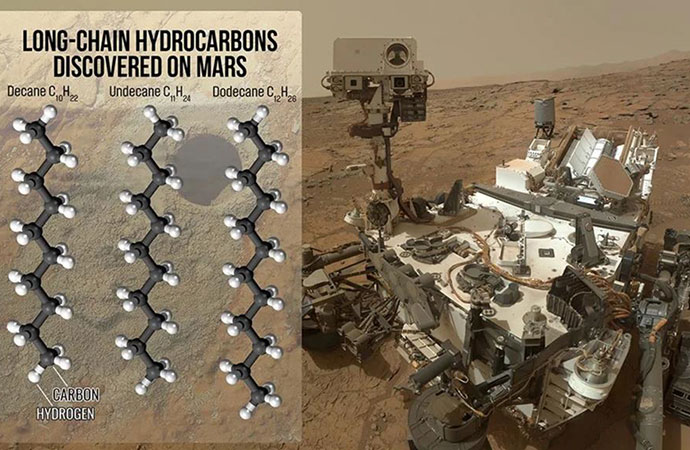Technology

Graphical representation of Curiosity detected hydrocarbons in the Cumberland sample. Source: Dan Gallagher/NASA
As the world's two superpowers reignite the forever flame for dominance far above the geopolitical fray, a new chapter in the space frontier unfolds, one that is no longer driven solely by high orbit ambitions but the universe's equation for life.
CNSA's Surf Find for Ancient Getaways
Mars, imagined to be barren since its accreted birth, has yielded secrets almost too Earthlike to believe all thanks to China's new rover. Deployed and active since 2021, the Zhurong has helped scientists unearth its once vast oceans rimming Utopia Planitia, in the planet's northern hemisphere. These ancient ocean surfs are believed to have pounded against the sun warmed sandy beaches about 3.6 billion years ago, as corresponded by Hai Liu, a professor with the School of Civil Engineering and Transportation at Guangzhou University and a core member of the science team for the Tianwen-1 mission.
Onboard the rover payload, Zhurong's Mars Rover Penetrating Radar, or RoPeR, has revealed gently sloping, layered deposits buried beneath the Martian crust, mirroring terrestrial beach formations. The geological fingerprints are quite distinct from dunes or lava flows. In lieu of expectations, they seem to be an ancient shoreline, a possible remnant of an enormous, long evaporated sea.
The Chinese, working with international collaborators, report that these "vacation style beaches" suggest a climate that may have stayed warm and wet for tens of millions of years longer than previously thought. "We are discovering locations on Mars resembling ancient beaches and river deltas... wind, waves, and ample sand, those akin to true vacation beaches," said Dr. Benjamin Cardenas, study co-author published earlier in February in the journal Proceedings of the National Academy of Sciences. For planetary geologists and astrobiologists, this is no longer just trivia; shorelines serve as prime locations to search for biomarkers, or even amino acids - the fundamental blocks of life.
"This stood out to us immediately because it suggests there were waves, which means there was a dynamic interface of air and water. When we look back at where the earliest life on Earth began, it was in the interaction between oceans and land, [...] capable of harboring conditions friendly toward microbial life." Cardenas continued. The structures strongly resemble coastal sediment deposits 'akin to those found in the Bay of Bengal', said the authors.
American Curiosity and the Case for Tiny Martians
NASA has countered with their own bombshell: NASA's Curiosity rover has drilled and analyzed the largest organic molecules ever found on Mars, in a 3.7 billion year old rock dubbed "Cumberland" within Gale Crater, reports Caltech's Jet Propulsion Laboratory. These are long chain hydrocarbons that on Earth are associated with the building blocks of cellular life.
While no direct evidence of ancient Martians are to be celebrated yet, the phenomenon of organics hints that prebiotic chemistry flourished when Mars was still a blue world.
Organic molecules of such size and intricacy are almost exclusively the product of sustained watery environments and represent remnants of fatty acids, all of which are critical components of cell membranes of all forms of life. Preserved for billions of years in a dried lakebed, through a tumultuous geological history, it is nothing short of curious, the surprise isn't merely in the presence of these compounds, but in their durability.
For now, scientists emphasize caution, as these molecules can be created abiotically as well, but with the shoreline context established by Zhurong and now organic richness confirmed by Curiosity, the framework for ancient habitability is stronger than ever.
"If life ever existed on Mars, it was likely microbial and small, hard to pin down, but these signs are our best clues so far," said a principal investigator on the Curiosity team.
At the same time, these Martian revelations are intensifying a strategic, and increasingly public competition between China and the United States. What's at stake is more than just national pride; it is influence over humanity's destiny as a spacefaring species.
The Contemporary Space of Affairs
Over the last two decades, China has undoubtedly evolved from mere industrial powerhouse to a true space power, methodically expanding its ambitions with milestones and its sultry military undertones. Their space program is now guided by a vision of 'no end', by which it moves a continuous, state supported progress toward pioneering lunar bases and Mars exploration.
For CNSA, the scope now extends to lunar water mining, cislunar station construction, and even asteroid defense. Both superpowers aim for Mars sample return missions, as Tianwen-3 and NASA's Mars Sample Return each seek to answer if we are alone.
As broadband infrastructure in low Earth orbit has become the battleground for hegemony, the U.S. maintains a short whip hand in privatized space and deep space operations. But experts warn that Chinese parity in key domains is now plausible within a decade.
While Congress heedlessly debates about posturing and needlessly counts its pennies to lend, CNSA closes the gap ever so quickly, all in the vacuum wake left behind by a distracted West.

























Leave a Comment
Recent Posts
Religion and Politics: A Toxic ...
At Dhaka University, cafeteria workers have been told not to wear shor ...
Enayetullah Khan joins AsiaNet ...
AsiaNet’s annual board meeting and forum was held in Singapore, ...
In a New York minute
Many leaders back a UN call to address challenges to ..
Defaulted loans at Non-Bank Financial Institutions ( ..
How the late Zubeen Garg embodied cultural affinitie ..